Introduction
Mars research began long before the Space Age. Ground-based astronomical observations using photometry (I.K. Koval’, N.P. Barbashev, et al.), polarimetry (A.V. Morozhenko et al.), and infrared spectrometry (V.I. Moroz) were performed in the Soviet Union throughout the 1950s and 1960s. G.A. Tikhov attempted to find evidence of life on Mars using spectroscopic techniques. Theoretical models for the internal structure of the planet began to be developed (V.N. Zharkov et al.). An overview of this period may be found in Ref. 1.
Early Soviet planetary spacecraft were developed by Special Design Bureau 1 (OKB-1, now NPO Energia) under the leadership of Chief Designer S.P. Ko-rolev (1907-1966). B.E. Chertok has brilliantly described this period of history in his topics (2-4). One of the primary motivations for the development of long-term Martian research programs was a desire to find life on the planet. It was generally understood that this project had to begin elsewhere—learning more about the planet Mars itself. Nevertheless, early Soviet spacecraft carried a spectro-photometer for observations of the so-called Sinton bands, which were, at that time, presumed to indicate the presence of organic material on Mars.
Eight attempts were made to launch a spacecraft to Mars, starting in 1962. Only the fourth spacecraft, the Mars-1 (1962) executed a flyby, but communications were lost prior to the flyby. Jet Propulsion Laboratory made two attempts (1964) during this period, one of which was successful: Mariner-4 performed a Mars flyby and transmitted an image of the planet.
In 1965, S.P. Korolev transferred all unmanned interplanetary space flight projects to another facility, the Design Bureau and Plant named after S.A. Lavochkin. The Design Bureau (”KB”) was managed by Chief Designer G.N. Babakin (1914-1971). Later (1974) this facility was re-named to Nauchno-Pro-izvodstvennoe Obyedinenie imeni S.A. Lavochkina (NPO Lavochkin or NPOL), in translation Reserach-Industrial Association S.A. Lavochkin. For simplicity we will use the designation ”NPO Lavochkin” for all periods covered below.
Many successful missions were carried out by NPO Lavochkin to the Moon, Venus, and eventually to Halley’s Comet, but, the USSR’s development of Mars projects was unsuccessful. Between 1969 and 1973, six Soviet spacecraft were launched, two in 1971 and four in 1973; however, virtually all of the new knowledge about Mars obtained by the early 1980s came from the NASA Mariner 9 and Viking missions. The Soviet contribution to research concerning the planet itself turned out to be quite meager, except for various issues relating to the interaction of the planet and its plasma sphere with the solar wind, where the Soviet Mars-3, Mars-5, and Phobos-2 spacecraft provided the basic results. It should also be noted that the Soviet Union was responsible for the first successful landing on Mars (Mars-2) and the first direct measurements performed in the Martian atmosphere (Mars-6). A NASA-published history of the NPO Lavochkin Mars efforts may be found in Ref. 5. The first papers discussing the scientific results of the 1973 Soviet missions were published in a special volume of the journal Ko-smicheskie Issledovaniya [Space Research] (6). A description of the major scientific research results related to the Martian atmosphere and surface obtained during both Soviet and American missions of that era may be found in Ref. 7.
Mars-2 and Mars-3 Spacecraft
The Mars-2 and Mars-3 unmanned interplanetary spacecraft were launched on 19 and 28 May 1971. Each spacecraft included an orbiter and a lander (Figs. 1 and 2). Upon arrival at Mars (on 27 November and 2 December 1971, respectively), the landers separated from the Mars-2 and Mars-3 spacecraft and reached the surface of the planet, thereby becoming the first spacecraft to attempt a landing on the surface of Mars. Each 1000-kg lander carried a pennant with the seal of the Soviet Union, a camera, and scientific instrumentation for studying soil samples. These were the first items made on Earth to land on Mars. The Mars-2 lander broke up at coordinates 44.2°S 313.2°W because of inaccurate targeting, which led to an error in the entry angle and caused the lander to impact on the surface before the parachute opened. The Mars-3 lander successfully landed on the surface at coordinates 45°S 158°W. The Mars-2 and Mars-3 orbiters (each weighing 2265 kg) were inserted into Mars orbit and performed a research program on the composition of the Martian atmosphere, surface photometry and IR radiometry, the magnetic field of Mars, and the interaction between the solar wind and the Martian plasma environment for more than 8 months. Both orbiters had cameras but no scientifically important images were transmitted. A global dust storm prevented imaging during first months after orbit insertion, and cameras failed by the time when dust dissipated. The Mars-2 and Mars-3 orbiters ceased operations in August 1972.
Mars-4 and Mars-5 Spacecraft
The Mars-4 and Mars-5 spacecraft for planetary studies of Mars from Mars orbit were launched on 21 and 25 July 1973 (Fig. 3). Mars-4 reached Mars on 10
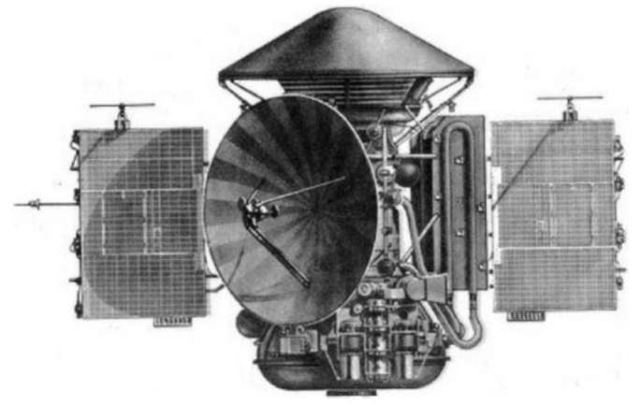
Figure 1. General view of Mars-2 and Mars-3 spacecraft.
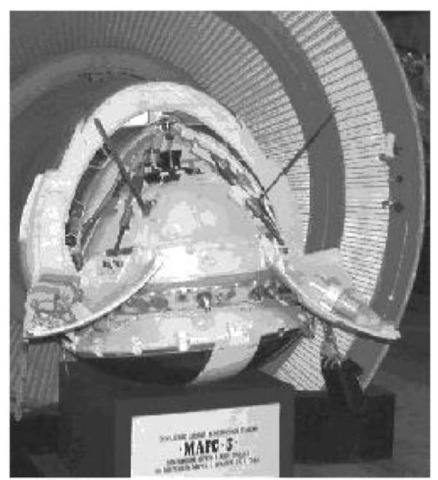
Figure 2. Mars-2 and Mars-3 landers.
February 1974 and passed within 2200 km of the planet’s surface without entering Mars orbit; however, it did transmit photographs of the planet to Earth. The Mars-5 spacecraft entered Mars orbit on 12 February 1974 (the orbiter had a mass of 2200 kg). The spacecraft continued operating once it reached Mars orbit; data were obtained on the atmosphere and surface temperature patterns, and approximately 120 surface photographs and panoramas of the Martian Southern Hemisphere were transmitted to Earth.
Mars-6 and Mars-7 Spacecraft
The Mars-6 and Mars-7 Mars spacecraft were launched on 5 and 9 August 1973. (Figs. 4 and 5). Mars-6 reached the planet on 12 March 1974. The descent module separated from the orbiter, landed on the surface of Mars, and performed direct measurements of the Martian atmosphere during its descent. Mars-7 reached the planet on 9 March 1974. The descent module separated from the spacecraft and performed a flyby 1300 km above the Martian surface.
After 1973, there were no USSR flights to Mars for many years. At that time, it would have been difficult to mount a standard mission (e.g., with a satellite and several lander modules) that could have obtained new scientific results at a level higher than that already achieved by the United States. There was a desire to undertake a project that would be more significant on a fundamental level. The project that was eventually selected involved the return of a sample of Martian material to Earth. NPO Lavochkin worked on this mission for several years, but the project turned out to be too risky and was eventually cancelled (5).
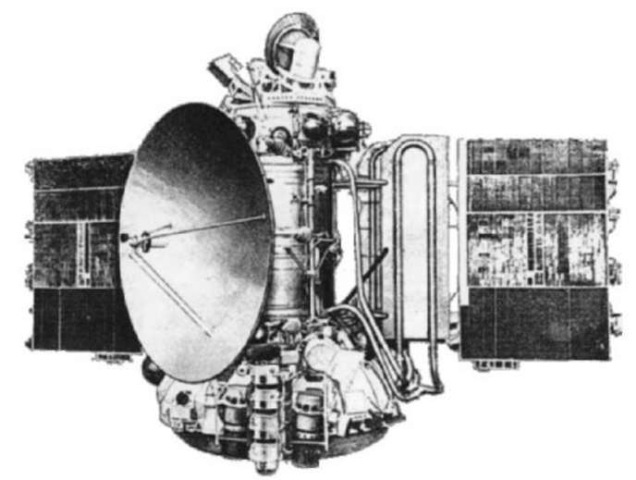
Figure 3. Mars-4 and Mars-5 orbiter.
During this period, the USSR successfully continued its flights to Venus. A new direction for research was pioneered by R.Z. Sagdeev. These were research projects related to two solar-system bodies, Phobos and Halley’s Comet.
Phobos-1 and Phobos-2 Spacecraft
The primary purpose of the Phobos spacecraft was to study not Mars itself, but Phobos (8). However, this mission was the next major post-Viking step in Mars research and marked the first mapping of the planet in the thermal infrared (the spatial resolution was approximately 1km at a wavelength of approximately 10 mm). Approximately 40,000 near-infrared (1-3 mm) images were obtained using a mapping spectrometer. At that time, no instruments of this type had yet been used, even in remote sensing observations of Earth. This mission also marked the first spectroscopic remote sensing of the Martian atmosphere via measurements of the solar spectrum at various altitudes above the limb in several wavelength bands; these data were used to determine the vertical water vapor and aerosol distributions. The first measurements of the dissipative flux in the upper atmosphere of Mars were made. Several interesting new results were also obtained for Phobos. Precise mass and density values were determined, and brightness was measured as a function of wavelength. The brightness as a function of wavelength did not conform to previously held views regarding the composition of Phobos. A large amount of unique data was obtained on the plasma environment of Mars and its interaction with the solar wind (9). Papers describing the scientific results of the Phobos mission were published in the journals.
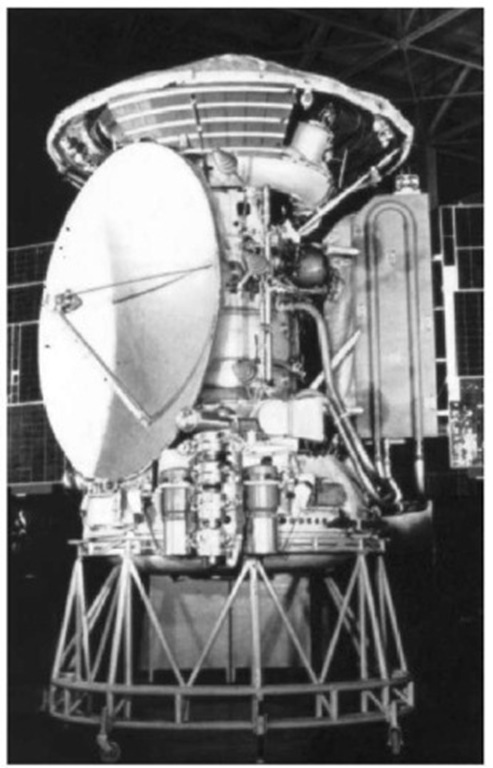
Figure 4. Mars-6/Mars-7 spacecraft.
Nature (10), Geophysical Research Letters (11), and Planetary and Space Science (12). Despite the fact that Phobos-1,2 was a short-term mission (transmitted data from orbit for approximately 2 months), the resulting scientific data exceeded the scope and quality of that obtained in all of the other Soviet Mars expeditions taken together.
The Phobos-1 and Phobos-2 new-generation spacecraft (Table 1) were launched on 7 and 12 July 1988, respectively (13) (Figs. 6 and 7). These spacecraft performed research on Phobos, Mars, and outer space (Fig. 8). Thirteen countries, plus the European Space Agency (ESA), were involved in developing the scientific instrumentation (Table 2).
Snyder and Moroz (14) provide information on the scientific instrumentation for all Mars missions (including Soviet), as well as a review of the major scientific results.
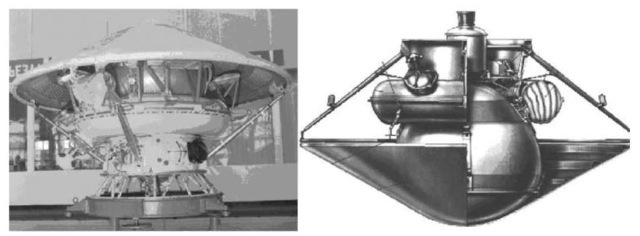
Figure 5. Mars-6/Mars-7 descent module.
After the end of the mission of the two Phobos spacecraft, an intense controversy erupted over whether another mission of the same type or a new mission should be developed whose primary goal would be to study the planet Mars itself. The latter point of view won out and led to approval of a very complicated project with the following five elements: a satellite in Mars orbit, small stations (landers), penetrators, a Mars rover, and an aerostat. The science experiments were largely developed within the framework of an international cooperative effort involving 20 countries. Launch was scheduled for 1994 but was then rescheduled for 1996. The situation was dramatic: Work on the project had begun in one country—the Soviet Union—and was continued and finally completed in another —the Russian Federation. The Russian Space Agency was established during this period, and Mars-96 became its first large scientific project. It soon became clear that it needed to be simplified. The Mars rover and aerostat were eliminated. However, there was a lack of funding, the project was continuously delayed, and the infrastructure crumbled. For the first time ever, the two-launch scheme had to be abandoned due to lack of funding.
Mars-96 was launched on 17 November 1996 but was unable to enter the transfer orbit because of a failure in the Block D stage. This was a catastrophe of a magnitude different from previous disasters. Many were convinced that this meant an end to the overall space-science research strategy inherited from the Soviet Union, with virtually unlimited funding, use of expensive launch vehicles, etc. However, it would have been very difficult for this strategy to continue, even had the Mars-96 launch been successful. Basic data on the Mars-94/96 spacecraft and its scientific instrumentation may be found in two Institute for Space Research preprints (15,16).
Table 1. Basic Specifications for Phobos-2 Spacecraft
| Launch date | 12 July 1988 |
| Mars-orbit entry date | 29 January 1989 |
| Duration of Earth-Mars flight | 200 days |
| Time spent in Mars space prior to Phobos flyby | 120 days |
| Duration of Phobos flyby | 25 minutes |
| Orbiter mass | 2600 kg |
| Mass of scientific instrumentation | 370 kg |
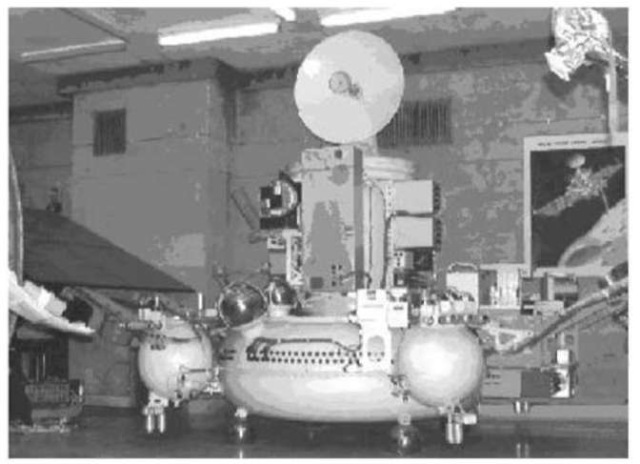
Figure 6. General view of the the Phobos-1/2 spacecraft.
While work on the Mars-96 project was under way, an attempt was made to organize bilateral cooperation between the United States and Russia in space-science research; this attempt was initiated by W. Huntress, who at that time was NASA Deputy Administrator for Space Science. The Cold War was now over, and it was logical to combine efforts in Mars research, as well as several other areas. Several options were generated for a joint flight to Mars under the title ”Together to Mars”: A Russian launch vehicle, an American orbiter, and a Russian descent module. For various reasons, this effort never proceeded beyond the preliminary discussion phase. This cooperative effort eventually merely amounted to participation of Russian scientists in three American Mars missions. Two of them (Mars Climate Orbiter and Mars Polar Lander) failed but the third (Mars Odyssey 2001) was successful. Important observations of ice in the subsurface ground layer were made by Mars Odyssey with the gamma-spectrometer package that includes a Russian instrument (high energy neutron detector HEND).
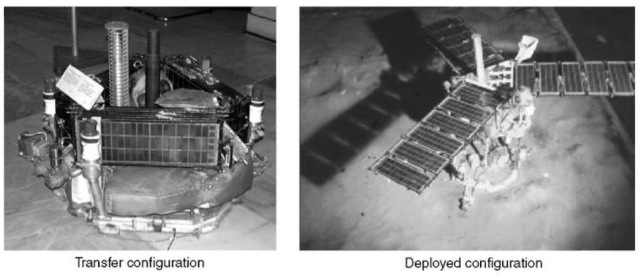
Figure 7. General view of Phobos long-duration automatic station.
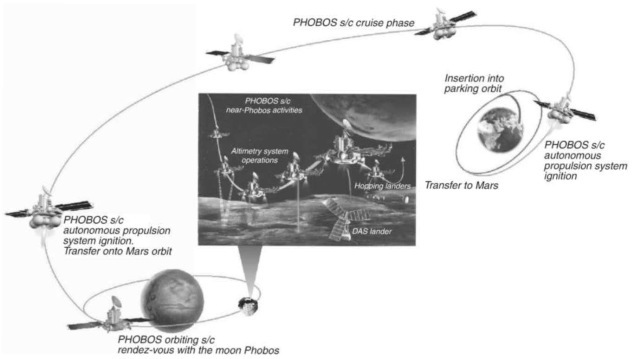
Figure 8. Phobos mission flight plan.
Table 2. Basic Specifications of Phobos Long-duration Automatic Station
| Total mass | 67 kg |
| Mass of scientific payload | 20.6 kg |
| Height | 1.8m |
| Solar-panel length | 2.5m |
Despite all of the lack of success in Mars research, Mars and its satellite, Phobos, remain highly attractive targets for the current Russian planetary program.
